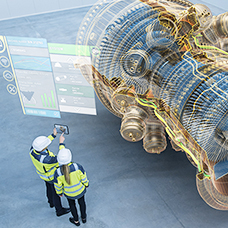 05-09-2020
05-09-2020
Unlike other domains, what's deployed can't be easily retrieved for problem-solving
You are probably hearing and reading a lot about digital engineering. At its core, it takes the acquisition, development, and sustainment of a product or system from the physical world to the virtual one. Doing this yields numerous benefits.
By using digital models, customers and engineers can more quickly specify, develop, and deploy solutions in response to a rapidly evolving mission space. Digital engineering is transforming acquisition, complex systems engineering and integration, and sustainment from the existing design-build-test paradigm to a model-analyze-build methodology. There are tremendous savings of cost, time, and resources by moving a solution through its full life cycle digitally.
Digital engineering is particularly critical to space programs. Unlike other domains where deployed assets can be more easily retrieved, maintained, and enhanced, what is sent into space is likely what the program is stuck with.
Whether the deliverable is a satellite or a spacecraft, digital engineering results in greater confidence – and thus lower risk – in the quality and performance of the solution. Digital technologies enable tools, methods, and processes to enhance transparency, collaboration, and communication among program stakeholders.
Greater insight and integration of development activities lead to better and faster decision-making and also lessen the chances of discovering costly design conflicts during the build stage of a program. This is vital to the speed and efficiency with which space organizations produce solutions for a rapidly changing operational and threat environment.
Complex systems and their capabilities have to serve a range of space missions and users. In the past, a sensing capability, for example, was typically optimized for a given satellite constellation using traditional engineering practices.
Through technological advances in areas such as analytics and computing power, digital engineering helps teams evaluate a solution’s capabilities against multiple missions and user requirements. SAIC’s digital engineering performs trade studies, enabling us to assess a great number of variables to determine the configuration that produces the most balanced solution.
We can now trade the combined effects of multiple payload types across multiple satellites in many and different constellations. This provides more resilient systems and greater mission assurance as well as systems that are more flexible to change with evolving mission needs.
As a leading space systems engineering and integration services provider, SAIC sees digital engineering as a pivotal tool in realizing an integrated space enterprise and transforming how stakeholders conceive, design, develop, and maintain complex systems. It will help redefine system life cycles and the sustainability of our space national security and exploration objectives.
FURTHER READING: SAIC is working as a trusted partner with the DOD at the heart of digital engineering. Learn more through the stories below.
Digital Engineering: Speed and Confidence for DOD
Mission Engineering for a Resilient Space Domain



